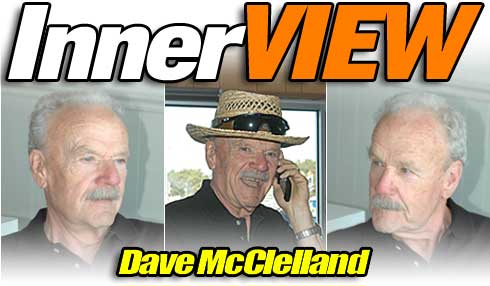
By Ian Tocher
Photos by Jeff Burk
10/9/06
For several decades of racers and fans who’ve listened to him at the track or seen him on NHRA’s television broadcast, Dave McClelland along with the late Steve Evans were the voices and faces of drag racing. “Big Mac” has virtually been in the sport since the earliest days and can say with some confidence that he has seen and been involved with most of history of the sport of drag racing. McClelland was the Grand Marshall for the ADRL’s Dragstock III at Rockingham Dragway and we took the opportunity to sit down with this legendary figure. It was easy: we just turned on the tape recorder and when McClelland saw the red light go on, he started talking until we ran out of tape. It is a fascinating look at drag racing from an insider’s point of view. Here is Part 1.
![]() How did you become interested in drag racing to begin with and how did you get started?
How did you become interested in drag racing to begin with and how did you get started?
Dave McClelland: I was born in the Kansas City area and as a teenager I got interested in motorsports and went to all the oval tracks around there -- like Lakeside Speedway, a quarter-mile dirt track -- and watched midgets and sprint cars like everybody did in the early 1950s. Drag racing came to Kansas City when they built a new track in 1955. I went to one of the original Drag Safari events at that Kansas City race track
![]() Was that the precursor to your involvement with the NHRA?
Was that the precursor to your involvement with the NHRA?
DM: I went to the 1956 NHRA Nationals at that same race track in 1956. I actually was working with a guy who had a Cadillac-powered dragster. He didn't win, but we had a good time. Then I went to college in Iowa and attended a few drag races. . .now, bear in mind, most of the race tracks in those days were either on abandoned roads or airports, either open or closed, so there were no real facilities. Then, I moved to Louisiana and went full time into the radio/TV business. In 1959, with some friends of mine that owned a speed
shop named Shreve Automotive, I went to a race in Carlisle, Arkansas, where the feature event was a match race between Eddie Hill and Don Garlits with Art Malone driving.This was after Garlits had gotten burned driving that year. For some unknown reason, the announcer that was working that race just froze when they ( Malone and Hill) came to the starting line, I was standing next to the track operator, who I knew and I said, do you mind if I get up there and try. He said, “You couldn't do any worse. Have at it.” So I went up there, picked up the microphone and started talking away. So I'm sitting there as the day goes on and I'm realizing that this isn't a bad deal. You've got the clocks right in front of you; you don't have to depend on some unstable announcer and a PA system for the information. You are elevated, where everyone else is on ground level sitting on the back of a truck or the hood of a car and I thought, you're right in the heart of the action.
I liked it and, as I said, I was working as an announcer in radio and TV so I wondered if anyone else would like to hire me, so I started mining the field and the next thing I know, within a year or less, I was working somewhere in the country almost every weekend. I announced my first NHRA national event in 1961 at Indy and very quickly became part of their permanent announce team and served them for nearly 45 years.